Product: Swedish surplus anorak (AKA snow smock, snow parka, vindblus, pull-over)
MFR stamp: Textil-Söm
Material: 100% cotton (I have read that these have been made from three materials over time - two 100% cotton and one cotton/poly blend. Mine are 100% cotton.)
Color: off-white, similar to stone khaki
Size: FV 50 (so-called XXL)
Measurements:
The following still in development:
Pattern: <download link>
My modifications: <thread link>
This picture album on flickr
I recently ordered four of these from Ireland (ebay). These are getting hard to find and quite expensive, and there doesn't seem to be much information about them available (not to mention a relative scarcity of free anorak patterns) so I thought I'd take some pictures and do some documentation before ripping mine apart. So, here's what I've got; hopefully it will give you some ideas. Bad and good things (wish I could use table formatting, but it isn't supported here...):
Tight armpits - Wouldn't be able to get much under there. Cold-weather smocks should have baggy armpits, perhaps even big enough to pull arms entirely into the body (for example, read about outer layers at wintertrekking.com).
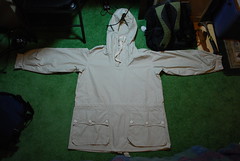
Tight cuffs - The cuffs are pleated too much. As you can see, about eight-inch circumference when buttoned, and still relatively small when unbuttoned.
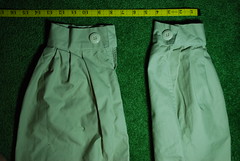
Hidden waist tie - The waist tie is inside, so the anorak must be flipped up more than one foot in order to access it. If a waist tie is necessary, two holes should be cut in the outside of the waist channel, and the ties should be pulled through to the outside. (If you ask me, wool sashes are better than waist ties any day.)
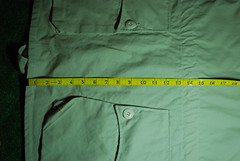
Some uneven stitching - There are two kinds of stitching. Main construction seams are all flat-felled (jean seam) with two chain stitches and are very nice, straight, and so on; finishing touches (joining pockets to body, waist channel, hood finishes, &c.) are a single running stitch and precision here is really hit and miss. Pictures in order: crooked stitching on waist tie tunnel, a rather poorly-sewn hood, a rather well-sewn hood, and one shot of the armpit as an example of the consistently good flat-felled seams.

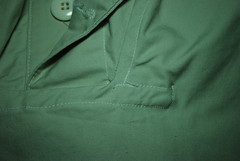
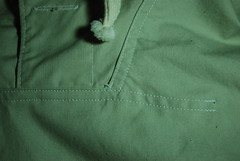
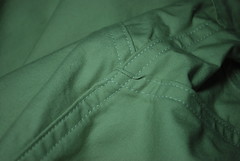
Weird hood area - It's just a little weird, not to mention the time it would take to button/unbutton all those buttons. On the other hand, the hood is nice and large, and the neck looks easy enough to modify with a triangular gusset or somesuch.

Ties? - Is this wick? I definitely removed mine. One good design point here though is a line of stitching going right through all tie tunnels at the midway point to keep the ties from migrating to one side (waist and hood, as well as the waist on the matching pants, but that's another story). And I might use these as snowshoe bindings, so another possible benefit.
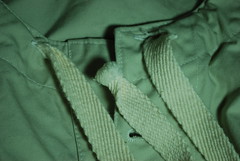
Decent gussets - Not much else to say about this one. Pictures of first top then bottom fabric of arm flat.

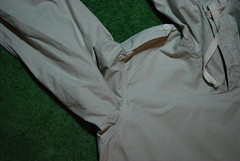
Well-designed pockets - I have never seen pockets like this before. The pocket extends about 2" up into the flap, so it is folded over like a paper lunch bag when the flap is down. Interesting. They are also nice and large. Not perfectly placed, perhaps, but easy to move around.

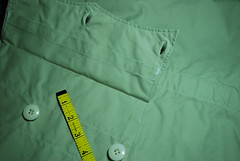
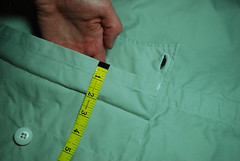
As noted above, probably a week or two until the mod/DIY post, so in the meantime here are a few threads specific to the Swedish surplus smock:
Eric Hammer
MFR stamp: Textil-Söm
Material: 100% cotton (I have read that these have been made from three materials over time - two 100% cotton and one cotton/poly blend. Mine are 100% cotton.)
Color: off-white, similar to stone khaki
Size: FV 50 (so-called XXL)
Measurements:
72 cm armpit to armpit
87 cm center back length from base of hood
94 cm sleeve length from center back
87 cm center back length from base of hood
94 cm sleeve length from center back
The following still in development:
Pattern: <download link>
My modifications: <thread link>
This picture album on flickr
I recently ordered four of these from Ireland (ebay). These are getting hard to find and quite expensive, and there doesn't seem to be much information about them available (not to mention a relative scarcity of free anorak patterns) so I thought I'd take some pictures and do some documentation before ripping mine apart. So, here's what I've got; hopefully it will give you some ideas. Bad and good things (wish I could use table formatting, but it isn't supported here...):
Tight armpits - Wouldn't be able to get much under there. Cold-weather smocks should have baggy armpits, perhaps even big enough to pull arms entirely into the body (for example, read about outer layers at wintertrekking.com).

Tight cuffs - The cuffs are pleated too much. As you can see, about eight-inch circumference when buttoned, and still relatively small when unbuttoned.

Hidden waist tie - The waist tie is inside, so the anorak must be flipped up more than one foot in order to access it. If a waist tie is necessary, two holes should be cut in the outside of the waist channel, and the ties should be pulled through to the outside. (If you ask me, wool sashes are better than waist ties any day.)

Some uneven stitching - There are two kinds of stitching. Main construction seams are all flat-felled (jean seam) with two chain stitches and are very nice, straight, and so on; finishing touches (joining pockets to body, waist channel, hood finishes, &c.) are a single running stitch and precision here is really hit and miss. Pictures in order: crooked stitching on waist tie tunnel, a rather poorly-sewn hood, a rather well-sewn hood, and one shot of the armpit as an example of the consistently good flat-felled seams.




Weird hood area - It's just a little weird, not to mention the time it would take to button/unbutton all those buttons. On the other hand, the hood is nice and large, and the neck looks easy enough to modify with a triangular gusset or somesuch.

Ties? - Is this wick? I definitely removed mine. One good design point here though is a line of stitching going right through all tie tunnels at the midway point to keep the ties from migrating to one side (waist and hood, as well as the waist on the matching pants, but that's another story). And I might use these as snowshoe bindings, so another possible benefit.

Decent gussets - Not much else to say about this one. Pictures of first top then bottom fabric of arm flat.


Well-designed pockets - I have never seen pockets like this before. The pocket extends about 2" up into the flap, so it is folded over like a paper lunch bag when the flap is down. Interesting. They are also nice and large. Not perfectly placed, perhaps, but easy to move around.



As noted above, probably a week or two until the mod/DIY post, so in the meantime here are a few threads specific to the Swedish surplus smock:
- MikeS@BCUSA, brown dye, hood cinch
- SurvivalMike@BCUK, grey-brown dye, antler buttons, Greenland waxing
- C_Claycomb@BCUK, extensive underarm gussets, chest pocket, fur ruff (scroll down for pictures)
- coralville@CCR, extensive underarm gussets, semi-kangaroo chest pocket (oldboyscout has a nice picture there too)
Eric Hammer
